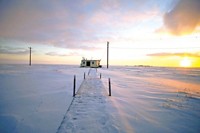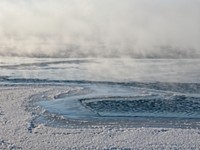Advertisement
Grab your lab coat. Let's get started
Welcome!
Welcome!
Create an account below to get 6 C&EN articles per month, receive newsletters and more - all free.
It seems this is your first time logging in online. Please enter the following information to continue.
As an ACS member you automatically get access to this site. All we need is few more details to create your reading experience.
Not you? Sign in with a different account.
Not you? Sign in with a different account.
ERROR 1
ERROR 1
ERROR 2
ERROR 2
ERROR 2
ERROR 2
ERROR 2
Password and Confirm password must match.
If you have an ACS member number, please enter it here so we can link this account to your membership. (optional)
ERROR 2
ACS values your privacy. By submitting your information, you are gaining access to C&EN and subscribing to our weekly newsletter. We use the information you provide to make your reading experience better, and we will never sell your data to third party members.
Environment
Connecting Ice And Air
Scientists probe the role of sea ice in atmospheric chemistry as the Arctic warms
by Jyllian Kemsley
December 5, 2011
| A version of this story appeared in
Volume 89, Issue 49
At the end of summer, sea ice covered 4.6 million km2 of the Arctic, according to satellite data analyzed by the National Snow & Ice Data Center. That was the second-lowest amount of ice observed since 1979, when satellites started keeping track. From 1979 to 1983, Arctic ice covered about 7.5 million km2. The lowest coverage was 4.3 million km2, in 2007.
Caused by rising global temperatures, shrinking sea ice in the Arctic poses significant concerns: Because sea ice reflects sunlight, having less of it could accelerate global warming and its attendant effects on weather patterns and ecosystems worldwide.
The loss of Arctic sea ice may also change atmospheric chemistry, because reactions on the ice surface play a role in the chemistry of the air above. Researchers are still in the early stages of understanding the interplay between ice and air in a remote region where concentrations of key compounds may be, at most, parts per trillion. Understanding these effects may provide clues to how rising temperatures in the Arctic will affect the globe.

Arctic atmospheric chemistry centers on halogens. Seawater contains chloride, bromide, and small amounts of iodide. As seawater freezes, those ions and compounds other than water get excluded from the bulk ice. The result is that sea ice somewhat resembles Swiss cheese, with brine contained in pockets and channels between ice crystal grain boundaries, says University of Alaska, Fairbanks, chemistry professor William R. Simpson.
The brine also winds up on the ice surface, where its contents can react with the air above. Undetermined chemicals in the atmosphere oxidize Br– and Cl– on the ice to form Br2 and Cl2, which enter the atmosphere. Sunlight then photolyzes Br2 and Cl2 to extremely reactive Br• and Cl•. The halogen radicals cleanse the atmosphere of ground-level pollutants by reacting with ozone and a variety of organic and inorganic compounds, including SO2 and mercury. The same can happen with iodide, although iodine chemistry appears to be more prevalent in the Antarctic, for reasons scientists don’t understand.
The polar halogen chemistry is unlike the atmospheric chemistry of the rest of the planet, which is driven primarily by ozone and HO•, says Paul B. Shepson, a chemistry professor at Purdue University. “As far as we know it’s a natural effect, although we don’t have a lot of evidence for what it looked like before there was human activity,” he adds. And still a lot remains unknown, such as the identities of the initial atmospheric oxidants and the mechanisms of the reactions.
Scientists are also probing the roles newly frozen, “first year” ice plays compared with “multiyear” ice that has survived at least one summer and is less salty. As ice ages over the summer, the salty parts melt first and flow to the ocean. Consequently, any ice that remains by fall and lasts through the winter contains less salt. For this reason, scientists expect first-year ice to promote more halogen chemistry than does multiyear ice.
Simpson and colleagues evaluated that hypothesis in a field campaign in Barrow, Alaska, in 2005. The group used differential optical absorption spectroscopy (DOAS) to measure concentrations of BrO, which is formed from the reaction of Br• and O3 and is an indicator of reactive bromine in the air. They found higher BrO concentrations in air that had contact with first-year ice rather than with either frost flowers—icy structures that form on top of the ice—or multiyear ice (Atmos. Chem. Phys., DOI: 10.5194/acp-7-621-2007). What this finding means for atmospheric chemistry overall in a warming Arctic, in which the ratio of first-year to multiyear ice is increasing, is an open question.
In addition to ground-based measurements, satellites also measure BrO in the air. Satellites have the advantage of constant monitoring as well as a geographically comprehensive view of the Arctic atmosphere. They also show a total column concentration that includes what’s in both the troposphere and stratosphere. A comparison of ground-based data and satellite data indicated that some of the BrO must be in the stratosphere, contrary to researchers’ previous assumptions that satellite-observed BrO “hot spots” were all close to the ground (Geophys. Res. Lett., DOI: 10.1029/2010GL043798). Localizing BrO to the stratosphere is “a really key finding because it tells us that we have to do a little more work to interpret that satellite data,” Simpson says. While it’s not yet possible to extract BrO altitude information from the satellite data, it may someday be possible by correlating with other observations, he adds.
In 2009, Arctic atmosphere researchers were able to augment their understanding by using mass spectrometry for the first time to look for chlorine as well as bromine species. Georgia Institute of Technology atmospheric chemistry professor L. Gregory Huey and colleagues found Cl2 that was “clearly being produced on snow and ice surfaces in the area around Barrow,” Huey says. The group found that, in turn, Cl• was oxidizing most of the methane in the air.

A field campaign in spring 2012 should reveal further details of Arctic atmospheric chemistry. Researchers will use DOAS measurements from an airplane to look for free-radical intermediates produced when Br• reacts with O3 to form BrO. They will also excise ice samples and pass oxidants over the surfaces to try to determine the airborne species that convert Cl– to Cl2 or Br– to Br2, Shepson says.
Conducting field campaigns in the Arctic isn’t easy. Locations with the necessary power and other supplies are few. And those sites are on coasts rather than on the ice itself, leaving scientists to “hope that nature brings air over to your site so you can study it,” Shepson says. During the occasional opportunities to go on ice, he adds, “there’s Murphy’s Law to deal with: If you put your instruments in a little shed on the ice and have a little generator to provide power and heat, God will wait until you have everything up and running and then the ice will crack and dump everything into the water.”
To get around those problems, at least in part, Shepson and others—Simpson, research scientist Paty Matrai and colleagues from the Bigelow Laboratory for Ocean Sciences, and collaborators at other institutions—are working on a field project called O-Buoy that places battery- and solar-powered buoys on the ice. The buoys are loaded with an ultraviolet absorption sensor to measure ozone, an infrared spectrometer for CO2, and a DOAS instrument for BrO. They also house meteorological sensors and a satellite communications system (Atmos. Meas. Tech., DOI: 10.5194/amt-3-249-2010).
The project has placed five buoys on the ice since 2009. A buoy gets deployed in the spring or summer; it collects data until the ice beneath it melts, leaving the buoy in open water and vulnerable to toppling by ice chunks floating nearby. O-Buoy then tries to recover the buoys and redeploy them. The team is still analyzing data from the first deployments, but “I think the promise of the project is that we’ll really be able to step away from the coastal sites and understand what’s going on in the middle of the Arctic Ocean,” Simpson says.

Away from the Arctic, laboratory studies of ice chemistry present their own challenges: In particular, the high vapor pressure of water means that standard surface science techniques, which are done under vacuum, can’t be used to study ice, says James Donaldson, a chemistry professor at the University of Toronto. Research has also shown that results obtained from doing reactions with ice and then melting it for analysis are different from those obtained when studying the ice directly.
Donaldson’s group has used glancing-angle Raman and fluorescence techniques to look at the reaction between ozone and bromide or iodide at the surface of frozen salt solutions. The experiments demonstrated that such reactions could form Br2 or I2, indicating that ozone may be a possible route to those gases in the environment (J. Geophys. Res., DOI: 10.1029/2010JD013929).
Donaldson and colleagues are now trying to determine the pH of the brine layer and how it might change under different conditions. Seawater normally has a pH of about 8, but its buffering capacity might change as it freezes because carbonates precipitate at about –2 ºC. Because the halogen chemistry likely depends on pH, determining the pH of the brine layer is important, Donaldson notes.
Computational modeling can also help unravel some of the brine-ice interactions. Molecular dynamics simulations by Shepson and coworkers, for example, show that the large polarizability of iodide and bromide ions drives them to the air-water interface of a salt solution (J. Phys. Chem. A, DOI: 10.1021/jp110208a). The enhanced surface concentrations of those ions may explain why air contains a higher ratio of iodine or bromine to chlorine species compared with the concentration ratios found in seawater, Shepson says.
Computational work can also help reveal details of brine formation. Columbia University chemical engineering professor V. Faye McNeill, for example, has used modeling to determine that the thickness of the brine layer depends on temperature as well as the identity and quantity of brine solutes—those that come from the ice as well as some that might be deposited from air, such as nitric acid (Atmos. Chem. Phys., DOI: 10.5194/acp-11-9971-2011).
As researchers unravel the pieces of sea ice-air interactions, it’s still unclear what changes are in store for the Arctic region as it warms. That is both the difficulty and the urgency of the work, Shepson says. “Climate change is a reality,” he says, “and that reality is very dramatically apparent in the Arctic.” Understanding the chemistry that goes along with it matters deeply for understanding the planet.





Join the conversation
Contact the reporter
Submit a Letter to the Editor for publication
Engage with us on Twitter